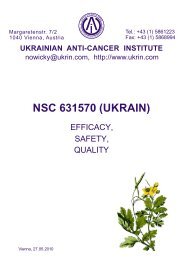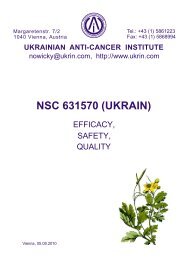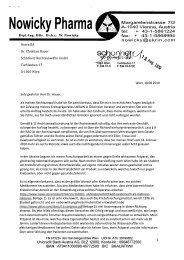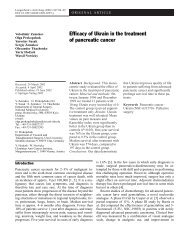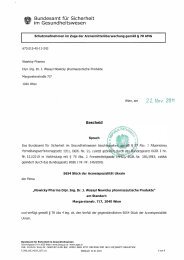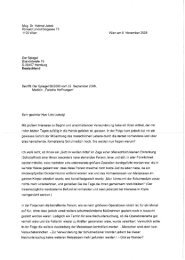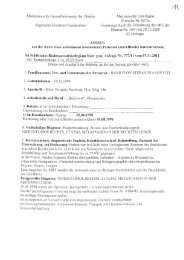Criminal Story of a Prevention - Ukrainian Anti Cancer Institute
Criminal Story of a Prevention - Ukrainian Anti Cancer Institute
Criminal Story of a Prevention - Ukrainian Anti Cancer Institute
You also want an ePaper? Increase the reach of your titles
YUMPU automatically turns print PDFs into web optimized ePapers that Google loves.
The case previously described which led Pr<strong>of</strong>essor Wodnianski to write to the<br />
Ministry <strong>of</strong> Science could now be supplemented with many other case studies.<br />
Also in the early 1980’s, when Ukrain had hardly been used on patients, a 43 year-old<br />
Vienna doctor (Dr. I.R.) underwent Ukrain monotherapy (treatment only with Ukrain, without<br />
conventional medicine) at his own request, treated by the internist, Dr. Alexander Schmid and<br />
the neurologist Dr. Walter Dekan. The precisely documented medical records show that he<br />
had been diagnosed with ‘metastases from a malignant melanoma’ following a fine needle<br />
biopsy on a growth in the armpit area. An operation was carried out to remove the growth on<br />
13 July 1983. The histological examination <strong>of</strong> two walnut-sized pieces <strong>of</strong> tissue produced the<br />
result, ‘lymph node metastases from a malignant melanoma’. On the day after the operation<br />
treatment with Ukrain was begun and in addition to the normal laboratory tests, melanin in the<br />
urine was also investigated. ‘The result was positive,’ stated the report, ‘so that a stage III<br />
cancer must be assumed.’<br />
During the course <strong>of</strong> six series <strong>of</strong> injections, which were carried out with pauses <strong>of</strong> 15<br />
days rising to a maximum <strong>of</strong> 60 days, the fluorescence <strong>of</strong> Ukrain was investigated. Wherever<br />
there were metastases fluorescence appeared after Ukrain had been injected. At first this was<br />
very clear but gradually reduced during treatment until it did not appear at all. While urine<br />
tests in July and September 1983 still showed melanin, in March 1984 no more melanin was<br />
found, a result that did not change after repeated examinations. The patient remained without<br />
complaints and without a recurrence <strong>of</strong> the disease.<br />
Case studies from the following ten years would fill a thick book on their own. Their<br />
findings resulted in a change in Ukrain therapy. Monotherapy proved itself to be not always a<br />
panacea. When tumours were too big but an operation was possible, then surgery was needed.<br />
It was also discovered that thanks to the accumulation <strong>of</strong> Ukrain around tumours, even when<br />
they had seemed previously inoperable, it now became possible to remove them surgically. In<br />
certain cases supplementary radiotherapy was also helpful. Nowicky only excluded<br />
chemotherapy, which along with cancer cells also destroys healthy cells and weakens the<br />
immune system and thereby the patient. However, Ukrain showed itself to be especially<br />
helpful after chemotherapy in rebuilding the body’s own defence mechanisms and improving<br />
the general condition, mostly in a spectacular way.<br />
However, the health authorities continued to ignore such reports and oncologists who<br />
had the opportunity to check the findings refused, at least <strong>of</strong>ficially, to use Ukrain<br />
experimentally. This meant that it was mostly general practitioners who prescribed Ukrain for<br />
their patients under paragraph 12 <strong>of</strong> Austrian medical law, which allows an unregistered drug<br />
to be used when the patient is at great risk and no other medicine can be expected to help.<br />
This paragraph was obviously a thorn in the side <strong>of</strong> the health authorities since it<br />
continuously reminded them <strong>of</strong> their ‘ban’ on Ukrain, notwithstanding the fact that this ban<br />
was invalid since the decree was in contravention <strong>of</strong> the law. Despite this, all health<br />
authorities throughout Austria received <strong>of</strong>ficial letters referring to this ‘ban’. These <strong>of</strong>fices<br />
threatened 150 doctors with sanctions.<br />
Finally exasperated at these circular letters Nowicky, via his lawyer Dr. Michael<br />
Graff, telephoned the Austrian Constitutional Court which promptly lifted the decree with the<br />
‘ban’ as ‘unconstitutional’ and on 26 February 1996 ordered the Federal State, i.e. the<br />
taxpayer, to pay € 940 to Nowicky as ‘compensation’, payable ‘within two weeks or goods<br />
will be impounded’.<br />
The eight-page document outlining the grounds for the decision <strong>of</strong> the Constitutional<br />
Court reads like an – unintentional – record <strong>of</strong> the tricks with which registration had<br />
continually been prevented. It states that the ‘authority being sued’ (the Ministry <strong>of</strong> Health)<br />
has answered the statements <strong>of</strong> the appellant (Nowicky) but ‘their explanation is too general<br />
and amounts only to assertions with no recognisable basis. It is partly also unclear what the<br />
authority being sued wishes to prove with their explanations.’ The Ministry <strong>of</strong> Health is also,<br />
35



